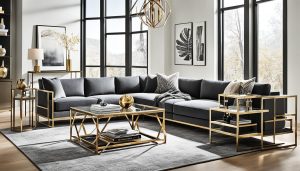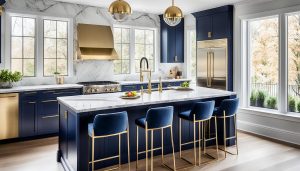Adding a touch of elegance to your home can be exciting. Mixing different metal finishes is a great way to do this. It brings depth, interest, and sophistication to your decor. Whether you love the warm look of brass, the modern feel of stainless steel, or the industrial vibe of iron, combining metals can change your space beautifully.
But, starting with metal finishes might seem tough, especially if you’re not a design expert. This guide will make it easy for you. You’ll learn how to mix metals in a way that looks great and shows off your style. We’ll cover the basics of metal finishes and give you tips for each room in your home.

When it comes to metal finish furniture, the possibilities are endless. From the sleek shine of stainless steel to the warm glow of brass, each metal furniture finish adds its own unique character. Mixing these metallic furniture finishes can elevate your decor, adding depth and visual interest.
The key to a visually striking space is understanding how different metal finishes work together. Each finish has its own color, sheen, and texture. By mixing steel furniture, iron furniture, aluminum furniture, and others, you can add complexity and sophistication to your design.
Exploring metal finish furniture reveals a wide array of options, including:
Each metal furniture finish has its own unique look, from the cool stainless steel to the warm bronze. Knowing how these finishes work together is key to mixing metals in your decor.
“Mixing metals adds depth and interest to a space, allowing you to create a truly unique and personalized design.”
Mixing metal finishes in your home decor can make your space look amazing. But, you need to do it with care to avoid a messy look. Here are some tips to help you mix metals well and make your design look great.
Experts say to use no more than 2-3 different metals. Using too many can make your space look busy and confusing. By picking a few metals, you focus your design and make it more interesting.
It’s key to have enough contrast between the metals you choose. For example, warm metals like brass go well with cool metals like chrome. This contrast makes each piece stand out and keeps the space interesting.
Even when mixing metals, pick one to be the main focus. This metal ties the design together. Then, add smaller amounts of other metals to add more style.
Follow these tips to make your metal mix look great. The goal is to balance different tones and textures for a cohesive look. This way, you can enjoy the beauty of each metal finish in your space.
Mixing metal finishes in your decor means paying attention to their color temperature. Warm metals like brass, copper, and gold work well together. Cool metals such as nickel, stainless steel, and chrome also pair nicely. But the magic happens when you mix both, with careful planning and balance.
Warm metals have golden, reddish, or bronzy hues. Cool metals show silvery, bluish, or gray undertones. Knowing these differences helps you create a beautiful mixed metal look.
Mixing warm and cool metal tones is a great design move. But, it’s important to balance them right so they don’t clash. The goal is to mix warm and cool undertones thoughtfully across the space.
| Warm Metal Tones | Cool Metal Tones |
|---|---|
| Brass, Copper, Gold | Nickel, Stainless Steel, Chrome |
| Reddish, Golden Undertones | Silvery, Bluish Undertones |
| Cozy, Inviting Feel | Modern, Sleek Aesthetic |
By balancing warm and cool metal finishes, you can make a design that’s interesting and harmonious. This approach highlights the beauty of mixed metals.
When it comes to metal finish furniture, mixing different metal finishes adds visual interest. It makes your home decor more engaging. Whether it’s for the living room, bedroom, or dining area, the right metal furniture with various metallic finishes can make a big difference. It brings a harmonious and intentional look to your space.
Using mixed metal finishes in your furniture lets you express your style. You can mix steel furniture, iron furniture, aluminum furniture, stainless steel furniture, bronze furniture, copper furniture, and brass furniture. This creates a layered, dynamic look that shows off your unique taste.
When picking metal finish furniture, think about how the finishes will work together. For instance, combining bronze furniture with stainless steel furniture and brass furniture accents can look striking. The goal is to balance the finishes so they complement each other well. This way, they won’t clash or overwhelm the space.
“Mixing metal finishes in furniture is a fantastic way to add depth, texture, and visual interest to any room. It allows you to showcase your personal style and create a truly unique, curated look.”
Adding metal finish furniture with mixed finishes can change your decor for the better. By trying out different combinations and focusing on balance, you can make a space that’s both eye-catching and reflects your style.

Creating a mixed metal design that catches the eye is all about the sheen and texture of the metals. Using different finishes like matte metal, polished metal, and hammered metal can make your space look better and more interesting.
Each metal finish has its own special look and feel. Matte metal has a soft glow that adds sophistication and an industrial feel. Polished metal reflects light, giving off an elegant and upscale look. Hammered metal adds an artisanal touch and makes your decor more interesting.
When you mix metal finishes, think about how the sheens and textures will work together. A mix of matte and polished metal textures creates a strong contrast. Adding hammered metal brings in an organic, handmade feel.
To get a look that works well together, balance the different metal sheens and textures in your space. By placing these elements carefully, you can create a mixed metal look that’s both beautiful and intentional.
“Mixing metal finishes is an art form that can elevate the overall design of a space. The key is to strike the right balance and create a harmonious interplay of different sheens and textures.”
Using matte metal, polished metal, and hammered metal finishes wisely can change your space. It adds depth, character, and sophistication to your mixed metal decor.
When you add mixed metal design to your space, balance and intention are key. Think about how metals sit together and use negative space in metal design. This makes your space look cohesive and beautiful.
Putting different metal finishes close together can look bad if they clash. Spread them out and use negative space to keep the design together. This way, your intentional metal mixing looks balanced and not crowded.
Mixed metal design loves negative space. It lets your eyes rest and keeps the look balanced. By placing your metal furnishings carefully, you highlight each finish while keeping the look unified.
“The key to successful mixed metal design is to create a sense of intentionality and balance throughout the space. By considering the proximity of your finishes and incorporating negative space, you can achieve a visually striking and cohesive look.”
Mixing metal finishes is about balance. With attention to detail and a thoughtful plan, you can mix different metal finishes smoothly. This creates a space that looks sophisticated and stylish.
Mixing different metal finishes can make your home look more interesting and sophisticated. But, you need to watch out for some common mistakes. These mistakes can mess up your mixed metal design. Knowing how to avoid them will help keep your space looking good and planned.
One big challenge with mixing metal finishes is finding the right mix of contrast and match. If you pick finishes that are too alike, your space might look messy. On the other hand, if they clash, it can be too much to look at. The goal is to find a good balance with enough metal finish contrast. This can be done by mixing warm and cool tones or matte and shiny finishes.
It’s tempting to use many metal finish elements, but don’t overdo it. Too many can make a room look crowded and messy. Experts suggest sticking to 2-3 metal finishes to keep your design balanced and focused. This way, your mixed metal look will be striking but not overwhelming.
By keeping an eye on these mixed metal design mistakes and following good practices for metal finish compatibility, you can mix metals well. This will make your interior design look great and put together.
When adding mixed metal finishes to your home, think about the room you’re working on. Each room has its own needs and design rules. Knowing these can help you make a look that’s both mixed and intentional.
In kitchens, it’s key to match all metal parts like plumbing and cabinet hardware. This makes the space look smooth and connected. Try mixing warm metals like bronze or gold with cool ones like stainless steel or matte black for a modern feel.
Like kitchens, bathrooms need metal finishes that work well together. Using different metals like brushed nickel and oil-rubbed bronze can make things more interesting. But make sure everything looks planned and put-together.
In living rooms and bedrooms, the aim is to add metal touches that fit the room’s style. You might use matte black lights with brass or copper decor. Or mix polished chrome with satin brass on furniture.
Thinking about each room’s needs lets you use mixed metal finishes well. This can make your home look better and more inviting.

Creating a mixed metal design in your home needs careful planning. The 60-30-10 rule is a key principle for a balanced look. It helps you mix metals in a way that feels intentional.
The 60-30-10 rule means your dominant metal finish should be about 60-75% of the metals. This main metal ties everything together, setting the style. Then, use 30-40% for one to two accent metal finishes that go well with the main metal.
This ratio makes your mixed metal design look thoughtful, not random. It lets the dominant metal finish stand out. The accent metal finishes add depth and interest without taking over.
Using the 60-30-10 guideline helps you find the right balance. You get a space that looks put together and well-thought-out.
“The 60-30-10 rule is a game-changer when it comes to mixing metals in your home. It takes the guesswork out of achieving that designer-approved, collected look.”
Mixing metals in your home decor can make your spaces look better and more interesting. It adds depth and sophistication. By learning about metal finishes and following expert advice, you can make a look that shows off your style. You can use mixed metals in furniture, hardware, lighting, or decor accessories.
Mastering the art of mixing metals in home decor opens up new creative possibilities. Learn about metal finishing techniques and metal coating processes to get the perfect look. With these tips, you can mix metals in your home with confidence.
Using mixed metals lets you create a space that looks great and reflects your style. So, start mixing, matching, and see how mixing metals in home decor can change your space. Your home will look amazing.